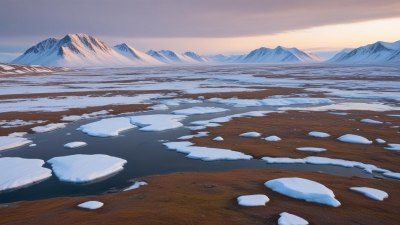The Surprising Science of Why Australia Has So Many Heatwaves and Cold Snaps
Explore the climatic factors contributing to Australia's extreme heatwaves and cold snaps.

This image was created with the assistance of Freepik
Australia's climate is renowned for its extremes, with stark contrasts between heatwaves and cold snaps. Understanding the science behind these phenomena is crucial in preparing for their implications on both the environment and human health.
One of the primary reasons for Australia's fluctuating temperatures lies in its geographical location. Positioned between two significant oceans, the Indian and Pacific, this vast continent experiences distinct climatic zones. The varied landscape, from deserts to coastal regions, leads to diverse weather patterns, contributing to frequent temperature extremes.
The Role of Ocean Currents
Ocean currents play a crucial role in influencing Australia's climate. The warm waters of the Indian Ocean bring humidity and heat, while the cooler currents from the Southern Ocean can lead to drops in temperature. The movement of these currents affects the atmosphere above, leading to varying pressure systems. For example, when the Indian Ocean Dipole (IOD) is in a positive phase, it results in warmer sea surface temperatures which can lead to increased humidity and heatwaves across Australia.
Conversely, a negative IOD phase can cause cooler sea surfaces, which may lead to cold snaps and increased rainfall. This interplay between ocean temperatures and atmospheric pressures is central to understanding how heatwaves and cold snaps develop.
El Niño and La Niña Effects
The El Niño-Southern Oscillation (ENSO) phenomenon further complicates Australia's climate. El Niño, characterized by warmer ocean temperatures in the central and eastern Pacific, often results in drier conditions for Australia, leading to severe heatwaves. During periods of El Niño, the risk of drought increases, which can exacerbate the intensity and frequency of heatwaves experienced across the continent.
In contrast, La Niña represents cooler ocean temperatures and typically brings increased rainfall, which can lead to sudden drops in temperature, manifesting as cold snaps. The oscillation between these two systems can account for significant fluctuations in weather patterns, causing Australia to oscillate between extreme heat and cold.
Climate Change and Long-term Trends
Climate change is another critical factor at play in Australia's climate. As global temperatures rise, the frequency and intensity of heatwaves are expected to increase significantly. Research indicates that periods of extreme heat will become more commonplace, with temperatures projected to rise dramatically by 2050. This change is attributed to greenhouse gas emissions, leading to global warming, which alters weather patterns and intensifies the effects of both heatwaves and cold snaps.
For instance, scientists predict that the average Australian temperature could rise by 1.5°C to 2°C by mid-century if current trends continue. This rise may lead to an increase in the number of days classified as heatwaves, affecting human health and agriculture. Prolonged heat can cause heat stress, dehydration, and other heat-related illnesses, particularly amongst vulnerable populations like the elderly.
Urban Heat Islands
Urban areas in Australia also experience more pronounced heatwaves due to the Urban Heat Island (UHI) effect. This phenomenon occurs where cities become significantly warmer than surrounding rural areas. Factors contributing to UHI include the extensive use of concrete and asphalt, which absorb and re-emit heat more than natural landscapes. As urbanization increases, the potential for extreme heat is heightened, leading to health impacts that must be addressed.
In cities like Sydney and Melbourne, the concentration of buildings and infrastructure can create conditions where temperatures are several degrees higher than in rural areas during heatwaves. Adaptation strategies are necessary to mitigate these effects, including increasing green spaces and implementing reflective building materials.
The Impact on Ecosystems
These fluctuations in temperature have significant implications for Australia's unique ecosystems. Both heatwaves and cold snaps can disrupt the natural habitat of numerous species, leading to shifts in biodiversity and ecosystem health. Extreme heat can cause stress to native plants and animals, leading to reduced reproduction rates and even local extinctions.
Wildfires are particularly concerning during heatwave conditions. Higher temperatures and prolonged droughts create an environment ripe for fires to ignite and spread rapidly, devastating large areas of land and threatening wildlife. Conversely, cold snaps can also affect ecosystems by freezing conditions that many Australian species are not adapted to endure.
Adapting to Climate Extremes
To cope with the increasing frequency of heatwaves and cold snaps, Australia must implement robust adaptation strategies. This includes investing in infrastructure that can withstand extreme temperatures and developing public health strategies that address the impacts of heat on communities.
Emergency response plans need to be enhanced to ensure that vulnerable populations are protected during heatwaves. Public awareness campaigns can educate communities about the signs of heat-related illness, emphasizing the importance of hydration, staying indoors, and recognizing the needs of the elderly and other susceptible groups.
Australia's climate is a complex interplay of natural elements, ocean currents, and human influence. As climate change continues to affect our weather patterns, understanding the science behind heatwaves and cold snaps remains vital for adapting to these challenges. Ongoing research and proactive measures will be essential in mitigating the adverse effects of these extremes, ultimately safeguarding Australia's unique environment and its residents.











